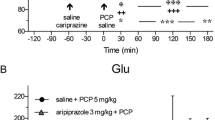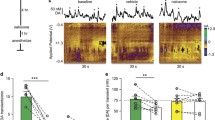Abstract.
Rationale: Acute morphine and abstinence from chronic morphine have been shown to increase and to decrease extracellular dopamine (DA) in the nucleus accumbens, respectively. In contrast, extracellular DA in the prefrontal cortex (PFC) is not modified by acute morphine and is markedly increased during abstinence syndrome. Objectives: We investigated whether the peculiar behaviour of PFC DA might depend on the fact that extracellular DA originates not only from DA but, mainly, noradrenaline (NA) terminals. Accordingly, we studied if the effect of acute morphine and morphine-abstinence was modified by the inhibition of DA or NA neurons. Methods: Extracellular DA and noradrenaline (NA) concentrations were determined by microdialysis in the PFC (densely innervated by DA) and in the parietal cortex (lacking DA afferents) both after acute morphine and in morphine-dependent rats during naloxone-precipitated abstinence syndrome. Dialysate catecholamine levels were evaluated by high performance liquid chromatography (HPLC) with electrochemical detection. Results: Acute morphine (5 mg/kg IP) reduced extracellular NA (by 30%) and failed to modify extracellular DA level in the PFC, but reduced both amines by 40% in the parietal cortex. The co-administration of morphine and the D2 agonist quinpirole (0.5 mg/kg IP) decreased both extracellular DA and NA by 40% in the PFC. In morphine dependent rats the administration of naloxone (1.0 mg/kg, SC) precipitated a typical abstinence syndrome associated with a concomitant dramatic increase in extracellular DA and NA by about 200 and 100%, respectively, in the PFC. The α2-adrenoceptor agonist clonidine (0.15 mg/kg IP) suppressed naloxone precipitated abstinence symptoms and brought both NA and DA output in the PFC to <50% baseline values. In contrast, quinpirole was totally ineffective. Conclusions: The results suggest that: a) morphine-stimulated DA release from DA terminals is compensated by reduced DA release from NA terminals; b) morphine abstinence-induced inhibition of DA release from DA terminals is overshadowed by a marked increase in DA released from NA terminals. Thus, the paradoxical response of PFC DA to morphine and morphine abstinence may be explained by the fact that extracellular DA in the PFC mainly represents the amine co-released from NA terminals.
Similar content being viewed by others
Author information
Authors and Affiliations
Additional information
Electronic Publication
Rights and permissions
About this article
Cite this article
Devoto, P., Flore, G., Pira, L. et al. Co-release of noradrenaline and dopamine in the prefrontal cortex after acute morphine and during morphine withdrawal. Psychopharmacology 160, 220–224 (2002). https://doi.org/10.1007/s00213-001-0985-y
Received:
Accepted:
Issue Date:
DOI: https://doi.org/10.1007/s00213-001-0985-y




